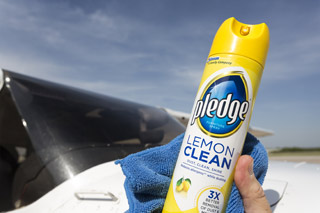 The height of bug season is a good time to review the best ways to remove their smashed remnants from aircraft windscreens and leading edges.
The height of bug season is a good time to review the best ways to remove their smashed remnants from aircraft windscreens and leading edges.
There are many specialized products that claim supremacy in this task—including Meguiar’s Bug and Tar, Bug Off, and Rain-X. But for a single, inexpensive, widely available product that works on both windshields and airframes, it’s tough to beat plain old Pledge.
The spray-on furniture polish softens up bug bodies, leaves a wax coating, and it doesn’t streak or stain. You can apply it in direct sunlight, and—unlike Windex or other ammonia-based cleaners—it won’t discolor Plexiglas. (And that lemon-fresh scent is a bonus.)
I was introduced to Pledge’s aviation applications by a cropdusting service in the Mississippi Delta whose airplanes spent their entire working lives in the bug zone. A few hours of summer flying would have windshields nearly opaque from collisions with a bewildering variety of winged insects.
Every ag pilot carried a can of Pledge in the airplane. On fuel and/or chemical stops, the pilot would spray the windshield with a generous coating of furniture wax, service the airplane, and then wipe the windshield with a terry-cloth rag (definitely not paper towels, which can scratch Plexiglas). At the end of each flying day, the leading edges of the wings and tail would get washed with soapy water and a scrub brush, and then rinsed with pressurized water from a spray nozzle. Before the first flight the next morning, the aircraft leading edges would get another quick coating of Pledge to keep the first barrage of bug bodies from sticking.
There’s no doubt that specialized windshield cleaners and polishes are superior to Pledge for that one purpose—and microfiber materials beat terry cloth (or old T-shirts, cotton socks, and shop rags) every time.
But for a single cleaning product that’s easy to bring along on flying trips, Pledge is peerless.
The only airframe cleaner I’ve found that works as well for less is warm water and hand soap. It only takes a few minutes to get a bucket and a rag and wipe down the leading edges after the last flight of the day, and doing so can be a pleasant way to unwind. (Of course, soapy water will leave a filmy residue on the windshield, so keep it away from there.)
The old truism, “A clean airplane is a safe airplane,” applies here, too. It simply means that discrepancies are likely to be found by pilots and technicians who touch every part of an airplane while washing it. That’s common sense and, as such, it’s free.
Email [email protected]
AOPA Frugal Flier coverage sponsored by Aircraft Spruce



